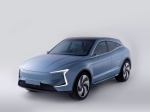China’s EV sector needs concrete revisions in the dual credit policy, not vague comments
Some pretty important statements regarding the future of China’s New Energy Vehicle market emerged from the just-concluded ChinaEV 100 Forum in Beijing. (Full disclosure: I was not there.) But as usual, the central government made only vague statements regarding NEV policy. What it needs to do is revise its dual-credit policy, because the one it has now isn’t working.
At the Forum, Miao Wei, minister of industry and information technology, said China is sticking to its goal of having NEVs represent 25 percent passenger vehicle sales in China by 2025. No surprises there, that was in the revised NEV policy put out for comment in December of 2019.
More importantly, China Daily reported that Miao said MIIT is working on guidelines for the NEV sector, including the dual-credit scheme.
“We are setting a target that new energy vehicle sales will account for a quarter of car sales in 2025,” he said. “It is challenging, but it will make the credits worth more money.”
Setting sales targets for NEVs won’t boost the price of carbon credits. Only a change in how credits are priced will do that.
Selling NEVs – which includes battery electric, plug-in hybrid electric, and hydrogen fuel cell vehicles but for all intents only means BEVs and PHEVS right now – is already challenging in China. NEV sales in 2019 dropped four percent to 1.21 million in 2019 compared to 1.26 million in 2018.
Sales are dropping in China’s overall light vehicle market due to a slowing economy and uncertainty due to the U.S. China trade war (the two are linked, obviously, though the trade war is not solely or even primarily responsibly for the economic slowdown).
But the slowdown in the overall market is not the main cause of the drop in NEV sales. The culprit is more than 60 percent cut in purchase subsidies for NEVs in June of 2019.
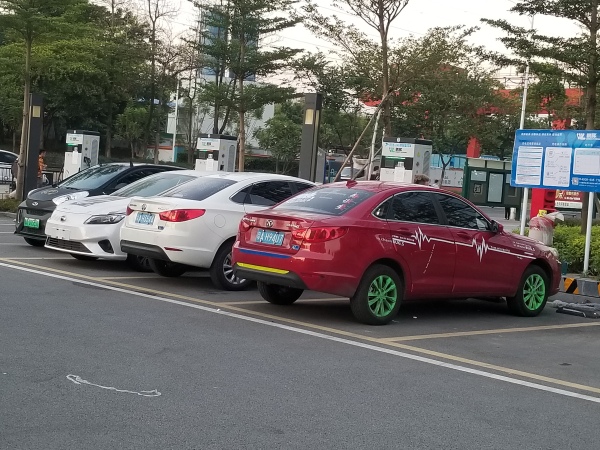
Public charging posts in Guangzhou
Though China’s central government is not going to return to the substantial NEV subsidies of past years, Wei did say that subsidies would not be cut more in 2020. That gives the NEV market some breathing room while the government tweaks details for the dual-credit policy, which it figured would be the driver behind NEV sales post-subsidy. What we don’t know is what those tweaks will be.
China’s approach to encouraging automakers to produce more NEVs is two-pronged. Its Corporate Average Fuel Consumption (CAFC) requirement – the equivalent of CAFÉ – compels automakers to produce fuel-efficient vehicles or NEVs to meet the requirement. The second part of the dual credit policy is a carbon credits system modeled after California’s Zero Emission Vehicle regulations.
The recently-released revised NEV policy made a vague reference to “optimizing” the carbon credit management system. Well, the policy certain needs some optimization. The suboptimal aspect of the current carbon credit system is that automakers can offset crummy fuel efficiency by producing battery electric and plug-in hybrid electric vehicles. Domestic automaker for the most part don’t have the technology to make their internal combustion engine vehicles fuel efficient enough, so rather than invest in that tech they produced a lot of BEVs (which earn more credits than PHEVs). That created a credit supply glut.
One way Tesla used to make a lot of money in California is by selling its excess ZEV credits to automakers who didn’t have enough of them. China envisioned the same kind of market developing there. That would help pay for the production of electric vehicles after subsidies were reduced and eventually eliminated.
But the supply glut reduced the price of credits too much. “You want to replace the subsidies with the credits, but now the credits can’t be monetized because there are too many credits,” Yunshi Wang, director of the China Center for Energy and Transportation at the University of California at Davis Institute for Transportation Studies. Wang helped China devise its ZEV policy.
For sure, China’s automakers would like a bit more policy clarity. Dong Yang, vice president of the China EV 100 think tank, reportedly asked the central government to “give automakers something they can expect. They need a stable policy and environment.”
Non-monetary policies were such as preferential vehicle registration and a sales tax exemption have been as effective as the purchase subsidy at promoting NEV sales in some cities. The new plan encourages local governments to continue with preferential registration policies and indicates the sales tax exemption will continue. Automakers at the China EV 100 Forum apparently weren’t shy about advocating for them to keep going, according to China Economic Net.
Beijing is in a tight place. It needs to put out some preferential policies to promote NEV sales. It has already admitted it won’t reach its initial lofty sales targets for this year but it isn’t giving up on longer-term goals. I figure it will lean on local governments to continue preferential policies. Those policies benefit local governments in locations where there are automakers anyway. Automakers will also continue to sell BEVs to ride-sharing fleets, mostly of their own creating. That is a more dubious route and has to be replaced at some point.
More tricky is revising the dual credit policy in such a way that the price of credits rises and automakers can make some money from selling them. Given the headache-inducing complexity of California’s and I’m sure China’s ZEV credit system, that will be quite an arduous task.
I just returned from a two-week trip to China doing research for my next report for Wards Intelligence, this one on autonomous vehicles. I will save my insights on that sector for the report itself, which will be out in coming months. Meanwhile, I have some thoughts on the electric vehicle sector, which I wrote about my first report for Wards Intelligence, China’s New Energy Vehicle Future.

BEVs charging at shopping area in Guangzhou
New energy vehicle sales – and right now we are only talking about battery-electric and plug-in hybrid electric vehicles – in China have slowed a lot. Not unexpected given the central government phased out purchase subsidies faster than initially planned. Why would it do this? Because the subsidies were encouraging cheating and not achieving the central government’s goal, which is for China to develop world-leading NEV technology.
Does this mean the electric vehicle sector in China is going to die a slow death? Not at all! Anyone who has watched China as long as I have knows that the central government is set on this plan. It’s part of Made in China 2025! But also, China’s government is pragmatic in its policy making. It tweaks plans as it goes, crossing the river by feeling for the stones and all. I expect Beijing will come out with some kind of new plan to boost NEV sales in a few months. Also, it wants the automakers themselves to figure out how to market and sell NEVs. And it likely wouldn’t mind some consolidation in the EV startup sector.
The big news in the EV startup sector while I was in China was, of course, NIO’s dismal results. Not unexpected. Does this mean NIO is dead? I think not. We still haven’t seen the outcome of the reported investment my Beijing E-town, which is of course the Beijing government. But state funds can’t be invested in loss-making enterprises, so it seems the aid will likely take the form of a loan to buy land in Beijing on which to build a plant. Why build a plant if your sales are dismal, one might ask? Chicken and egg scenario. But I think NIO will move forward with the plant. Its cars are as good or better as other EVs out there.
NIO’s troubles do, however, speak to a contradiction in these start ups development plans. As I wrote in China’s New Energy Vehicle Future, EVs must be the building block of a digital lifestyle in China. The question is, how to make a car seem like something as important to Chinese consumers as the next mobile phone. NIO tried/is trying to do that with its NIO houses, lifestyle products, etc. But those things cost a lot of money. And NIO chose some pricey though prestigious areas such as the Nanjing Lu area in Shanghai, to open its stores. Next to a Tesla store, let me add. Important to the brand image but big money sucks.

Tesla store in Xintiandi, Shanghai
Interestingly, another EV startup, Qiantu, is spending its money on a storefront in the prestigious yet pricey Xintiandi shopping area of Shanghai. Qiantu doesn’t have a vehicle on the road yet, so this is a big investment on an uncertain future. There is a Tesla store a few doors down, btw.
Meanwhile, I visited the Xpeng headquarters in Guangzhou to interview founder He Xiaopeng.

While there I met the guy in charge of developing Xpeng’s distribution locations. Former real estate guy. Xpeng isn’t going to be spending money on outlets in expensive areas such as Xintiandi, he said. Another startup, WM Motors, is aiming to be the EV for the masses. I admit that I don’t know where its stores are located. But given its goal, I don’t think it will be opening any stores in Xintiandi either.
When I read about WM Motor’s idea to launch a trading platform for second hand electric vehicles, my initial thought was that it was doomed to fail. How will WM determine residual value for those vehicles, I thought? After talking with some experts I’m still not convinced it won’t end up being a total money suck. I do think it will serve a useful purpose, however, and may end up being a success.
Of course, the motivation behind launching this second-hand EV trading platform is to create a market for WM’s battery electric vehicles. The Shanghai-based startup currently offers one model, the EX5. It starts at less than 200,000 RMB before a government subsidy. It has delivered more than 9,000 units.
Make no mistake, however. WM Motor aims to be a volume brand. Big volume. “I want to become the Volkswagen or Xiaomi of the EV sector,” co-founder Freeman Shen told me when I interviewed him at the WM Motor headquarters in Shanghai in February. “I don’t want to be Mercedes.”
WM’s goal is to be the best-selling BEV in China in terms of delivery 2021, he said. It plans to launch two more models this year and two in 2020. So, launching the second-hand EV trading platform makes a lot of sense. But it is risky.
To get an idea of how risky this endeavor could be, I talked with Cari Crane, director of industry insights at ALG, a division of TrueCar. ALG is a residual value specialist. Crane has a lot of insight into residual values for the U.S. used EV market, which is a lot more mature than China’s.
One thing that put a lot of downward pressure on used EV (and here I am referring only to BEVs), she said, is incentives. In the U.S., BEVs can qualify for up to $7,500 in federal tax credits. Those incentives reduced residual values a lot, she said, up to 20 percentage points. So, for example, if an ICE vehicle was at 50 percent of the original value, a BEV would be up to 20 percentage points lower, or 30 percent lower than the original price.
The arrival of the Chevrolet Bolt was a turning point, she said. It offered a comparable range to an ICE vehicle, and it wasn’t weird looking (not her exact words). Now, luxury performance BEVs such as the Audi e-tron are also coming on market. People will pay a premium for performance. Those trends — longer range, less polarizing design, and performance — are helping EVs maintain more residual value.
Leasing is a another negative for EV residuals, said Crane. Since most of the leases are 36 months, that creates a flood of EVs coming back onto the market at the same time. But more consumers are now buying the highe- range BEVs, she said.
One thing Crane didn’t talk about until I asked is how fear of a shortened battery life impacts the residual value of an EV. Nissan LEAFs and Tesla Model S EVs have been on the road for a long time and their batteries seem to be holding a lot of range. So consumers are becoming more confident, said Crane. Hefty OE warranties help, too, though they can increase the price.
In the end, it seems incentives are the biggest drag on residual value for EVs. While China is now phasing out its NEV purchase incentives, all the models on the road now were heavily incentivized. That will put a lot of downward pressure on their resale value. That’s something WM must deal with as it grows its second-hand EV trading platform.
The platform could do what WM aims for it to, however, which is create consumer confidence in its vehicles and thus a market for them. A consumer who buys a WM EV will be able to check its second-hand value beforehand, and feel comfortable (or not, depending on the market, I guess) that he or she can re-sell it. There isn’t a lot of historical information in China on residual values for second-hand EVs, but apparently a Tesla retains 60 percent or more of its value after three years. Once a lot more Teslas are on the road in China, of course, that may change. The trading platform may help create a market for second-hand EVs in smaller cities, as well. The lower price will appeal to buyers there.
Education will be crucial to the platform’s success, however. Some consumers who have bought second-hand EVs reportedly had a lot of trouble recharging because they weren’t allowed to install chargers at their place of residence, or other road blocks. WM will need to pay a lot of attention to educating buyers.
I think WM should open this platform to all brands of EVs. A lot of second-hand EVs will be coming on the market in coming years. Allowing many brands to be traded will benefit all, in my opinion. If WM’s vehicles are as good it claims, it will get a bigger piece of a bigger pie. But, WM Motor also needs to make sure the platform pays as much attention to educating buyers as it does to selling them EVs.
China EV maker Seres adjusts U.S. plan to fit reality
Several Chinese EV makers have recently scaled back their U.S. market plans. One, Seres Automotive, at least has a Plan B, its new co-CEO Jim Taylor tells ChinaEV. It aims to be both a contract manufacturer at its U.S. plant and a supplier of electric vehicle drive train technology. Launching an electric vehicle in the U.S. is on hold for now, he says.
Seres is the new name – and brand name, it seems — for the vehicles produced by SF Motors, which is a subsidiary of Sokon Industrial Group, a large privately-owned manufacturer in China. More on Sokon later.
![]()
You may be familiar with Seres, though you didn’t know it. The EV maker opened an office in Santa Clara, CA, in Silicon Valley, in 2016 under the name SF Motors. Like many Chinese automakers it started out with a very ambitious plan, and moved quickly. It opened an research and development center in Silicon Valley in March of 2017. In October of 2017, Seres acquired battery startup inEVit, Inc. In November of 2017, Seres acquired the former AM General manufacturing plant in Mishawaka, IN. In April of 2018, it established a second Silicon Valley R & D center. Then reality set in.
Taylor is not new to working for Chinese companies. Most recently, he has held various positions at Karma and Fisker, two EV startups with Chinese owners, albeit radically different types of Chinese owners. That is for a different blog, however.

That experience may serve him well. Taylor came on board as Seres co-CEO in May; he shares the CEO role with Hu Xindong, who established the U.S. operations. Hu had a long career with Dongfeng, with whom Sokon has a joint venture. Hu has an MBA from the Maastricht School of Management in the Netherlands.
I know, I’m thinking the same thing. This may be a tricky relationship given that Taylor is completely re-doing Seres’ U.S. strategy, which Hu created. Also in the mix is John Zhang, son of the owner of Sokon Industries Group. John Zhang is listed as CEO of Seres on the U.S. website while Taylor is co-CEO of Seres Automotive. I guess John Zhang is in charge of the brand in China?
Taylor had a long career with General Motors, including a stint as CEO of the Hummer brand. (That surely helped put the Indianapolis plant on his radar as AM General manufactured Hummers there.). Taylor was also with GM’s Cadillac brand for more than 10 years, including as general manager and chief marketing officer. The Chinese press really talks about the Cadillac experience a lot.
When he came on board at Seres in May of this year, Sokon Group was already ready re-thinking its aggressive schedule for the U.S. market, says Taylor. That schedule called for launching the Seres brand in China and the U.S. at almost the same time, This is a new brand, mind you. And, Sokon has little experience selling passenger cars, much less electric vehicles.
Sokon Industry Group is listed on the Shanghai Stock Exchange. Its vehicle portfolio in China consists primarily of small ICE commercial vehicles, which it manufactures through a joint venture with Dongfeng. Sokon also manufactures its own line of small electric vans and manufactures “energy-saving and eco-friendly engines” which it sells to other manufacturers.
As for the change in the U.S. business plan, Taylor says he helped Sokon/Seres “see the situation” more clearly and add some momentum to the business plan change. “To try to launch simultaneously in two countries when it is a new brand in both is more what an enormous company could handle,” he says. “Seres needs to get the brand off the ground (in China), then come back with a second launch in a new country.”
On top of that, add the downturn in China’s economy and the “messy,” as Taylor termed it, relationship between the U.S. and China right now (the economic downturn in China is not helped by the trade situation but is also not the cause. And in any case, China takes the long view, as Stephen Roach points out in an excellent blog posting.)
To Zhang’s credit, though Sokon has invested millions in the U.S. plant and R&D facility, had “strong intentions to manufacture vehicles here” and was “going full-speed towards that,” according to Taylor, it has put the brakes on the U.S. vehicle manufacturing for the time being.
“We had to let a few people go (who were) lined up to execute the old business plan, says Taylor. It laid off 30 employees in Mishawaka and 17 in Santa Clara., says Taylor.
Though Seres won’t be producing EVs in Indiana right now, that doesn’t mean Seres has no commercial opportunities in the U.S., Taylor says. It will, to use a painful-to-type word, pivot. “Just because we had a prior business plan doesn’t mean we have to stick with that,” he says.
One business area Seres is pursuing now: supplier. “We have a very large powertrain team in Santa Clara,” says Taylor. He says he is spending 80 percent of his time in Silicon Valley.
Engineers at Seres took a vertical approach to developing the EV powertrain. “They started from the bottom,” says Taylor, including designing the gear box, the motor, and building their own inverters. Since the powertrain is already incorporated into vehicles in China, it has been undergone millions of kilometers of testing, he adds. Taylor figures Seres could turn into a Tier 1 supplier of EV components or an entire drivetrain.
The Santa Clara R&D center (or maybe the Milpitas location…) has “legitimate IP,” says Taylor. “They are not integrating other’s products.” Taylor claims the Seres electric powertrain is as good or better than anything on the market, “better than the current Tesla systems.”
Sokon Industry Group, based in the southwest China municipality of Chongqing, introduced the first Seres model, the SF5 SUV BEV, in April of this year at the Shanghai Auto Show. The SF5 (below) will be intelligent and connected, natch. It will be on the market by the fourth quarter of this year, says promotional material. It is also developing a second model, the SF7.
Alas, I didn’t know I’d be blogging about this or I would have attended the Seres presser at the Shanghai show. I did manage to attend, or at least take photos of, electric SUVs being launched by Bordrin, Aiways, Evolve, Gyon, Hozon, Lixiang, Singulato, Xiaopeng, Qingyuan, NIO, WM, Red Flag (FAW), Venucia (Dongfeng), and JAC, among others.










Get my point? The segment is pretty crowded. Seres faces a challenging market in China. As establishing the brand there is a bit of a prerequisite for launching it here, it’s a good thing Seres is currently pursuing Plan B.
As for the second part of Plan B, i.e. selling manufacturing capacity at its Indiana plant, Taylor figures there is a place for contract manufacturing, in the U.S. “There hasn’t been a lot of contract manufacturing in the U.S. since AM General,” he says. The Indiana plant has a 50,000 unit annual capacity running two shifts daily, and an experienced workforce, Taylor points out.
Customers could include established automakers who need temporary capacity, want to do small-volume manufacturing with a model, or have other limited scale production needs, he says. Startups are another potential customer pool. Many of them are looking not only to fund a product program but also to find a plant to manufacture the product in. Buying or building a plant at such an early stage is expensive. Seres’ capacity could be a “bridge plan” for the startup’s first two or three years, says Taylor.
There are a lot of uncertainties in Seres’ U.S. future right now, Taylor admits. One of the biggest is when China and the U.S. “shake hands.” That will help determine when the brand can launch here (though that is predicated on a successful China launch, so another uncertainty…). Even if China and the U.S. resolve some differences, there will be local content requirements to manufacture here. So Seres will need to localize some sourcing in the U.S. almost immediately.
Meanwhile, Taylor is hopeful his new approach, involving contract manufacturing and selling EV powertrains, will succeed. “We have bites for both lines of business. This might have some legs,” he says.
BYD has long been loathe to share its battery technology with other automakers. Of course, some would say that is not a huge loss as BYD doesn’t have the best battery technology around. There have been rumblings of change at BYD of late, however. When I interviewed BYD Auto Sales Co. vice general manager Li Yunfei in Shenzhen in March for my China’s NEV Future report for Wards Intelligence (buy a copy to read the interview!), he told me BYD was going to “open our product to other automakers.” He also predicted that BYD would have more than 20% of the EV battery market by 2020.
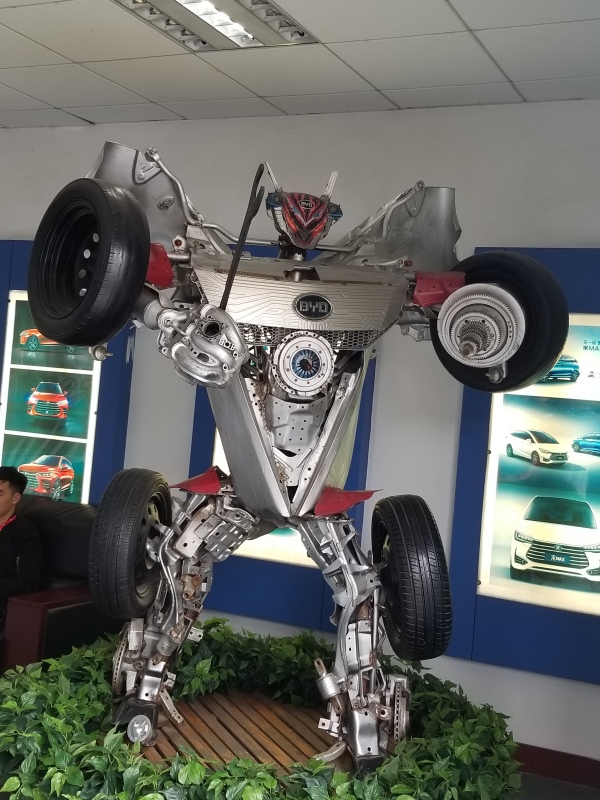
BYD Transformer in lobby of BYD Shenzhen plant
I am still skeptical that it can do that, but the recent announcement that Toyota and BYD are cooperating to produce BEVs and batteries validates that a tiny bit more. For those of you who don’t obsessively follow the China NEV market, on July 19, Toyota and BYD announced they would be cooperating to develop battery-electric sedans and “low-platform SUVs” as well as batteries. The vehicles will be badged Toyota and the plan is to have them on the market in China before 2025. Nothing more on the battery plan.
The rationale for this partnership was given as: “To curb global warming, both BYD and Toyota seek to reduce CO2 emissions by promoting the widespread use of BEVs. To accomplish these goals, both companies believe there is a need to put aside their rivalry and collaborate; therefore, the two companies have agreed to jointly develop BEVs.”
That sounds very nice, but we all know these two need each other. I, for one, think BYD has more to gain from this partnership.
Sure, Toyota has been a BEV skeptic, touting its hybrid and fuel cell technology. That has put it behind in the BEV stampede. But it must produce BEVs in China to meet CAFC and ZEV quotas (for Toyota, much more a ZEV issue). Its partnership with BYD serves the same purpose as Ford’s with Zotye though I’d argue that Toyota got a far superior — but perhaps more argumentative — partner. With BYD, Toyota can produce lower-priced BEVs to serve that segment of the market in China. Conveniently, BYD already has decent BEV technology. But I don’t know how much Toyota will build on that versus trying to come out with something new and better. Given time constraints, the new and better approach may not be possible in the near term, so it will just go for better.
Toyota is also hedging its bets with the BYD partnership. It already has a supply agreement with CATL, which has superior battery technology. But as my friend Tu Le at Sino Auto Insights pointed out, CATL has partnered with a lot of foreign and domestic automakers. It is already producing lots of batteries. So, it will scale up faster, reducing the cost of the battery more quickly. Meanwhile, BYD and Toyota can work on building a battery together.
I asked the PR folks at BYD in Shenzhen what form the cooperation will take. “A final conclusion has not been reached; it will be discussed in the future,” they said. A final conclusion not been reached on where the BEVs will be manufactured. No info was available on how the decision to produce a sedan and a low-platform SUV was arrived at. So it seems this partnership is in the incipient phase. There are likely answers, but maybe both sides haven’t agreed what they are yet!
As I mentioned, I think BYD is will get the most out of this partnership. BYD produces some nice buses, and its passenger vehicles, both electric and ICE, have improved.

BYD Tang in dealership
But let’s face it, BYD will benefit from some Toyota production technology. Toyota isn’t exactly known for its super-stylish design language, but a Toyota will run forever and be basically problem-free. BYD has that new design center – it can help with some stylish design language for the Toyota-BYD BEVs.
Tu pointed out another potential big benefit – BYD could gain access to Toyota’s distribution system in the U.S. BYD totally blew its first effort to set up a distribution network and sell passenger BEVs here but having the Toyota name hovering around the BYD logo won’t hurt.
I will be interested to how the two firms work together. Wang Chuanfu is kind of a control freak, I think, though he is also a super smart businessman who has given up control when it really counts, such as the Volvo acquisition. Meanwhile, Toyota probably wants a lot of control, as well. If they set up a manufacturing JV, will Toyota get a majority share? I think not. Betting on 50/50.
China has that “same bed, different dreams” saying. Will be fun to see if Toyota and BYD are having the same dream.
WM Motor aims to be China’s BEV for the masses
I was in China the last half of February doing interviews for a comprehensive report on China’s NEV sector I am writing for Wards Intelligence. It should be out in May. Everyone buy it!
One of the folks I interviewed was my old friend Freeman Shen, whom I met in the year 2000 or so when he was head of BorgWarner China. That doesn’t even come up in his list of positions nowadays it was so long ago. He went on to be a top exec at FCA and Volvo/Geely. Now Freeman is putting those years of experience and connections to good use at WM Motor, an EV startup initially known as Weltmeister, Its Chinese name remains Weima.
My Wards Intelligence report is looking at how NEVs in China are the basic unit of a digital lifestyle. I tend to think of that as meaning a way to get content to consumers, but Freeman looks at it from the other angle – as a big data gathering advice. WM’s BEVs are part of a digital ecosystem, he told me, one where owners use the connected car to meet your daily needs from paying for insurance for the car to paying for parking, electricity, and everything else Chinese already do digitally anyway using WeChat.
Rather than portraying itself as a part of an entire digital lifestyle the way NIO and Byton do, WM Motor sees itself as a vehicle company. But the vehicle is a “rolling data collector,” says Freeman.
“We are a hardware company,” he says. “The vehicle is smart hardware, a way to capture big data to improve performance.”
WM Motor is currently selling one BEV, the EX5 SUV. Freeman says “thousands” of units have been delivered since it went on sale in Beijing in December of 2018. The price before incentives is 200,000 RMB. He doesn’t fear the end of government subsidies (which is good as it happens soon.)
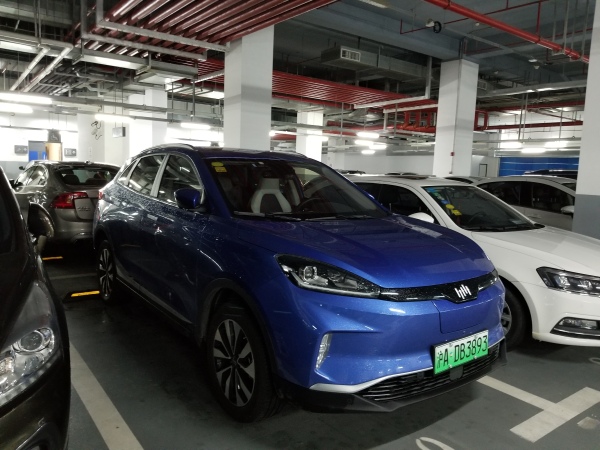
WM EX5 in garage under building where EV maker has an office.
“I like it that they are cancelling the (NEV purchase) incentives,” says Freeman. “We are already at a lower price point.”
It hasn’t announced sales volume goals yet, but WM Motor aims to be number one on a delivery basis by 2021, says Freeman. He emphasizes delivery to differentiate WM from EV startups that talk about volume in terms of sales but not how many vehicles have actually been given to the owner. Have no doubt, however, volume sales are Freeman’s goal. Big volume. WM Motor will launch two more models in 2019 and two models in 2020.
“I want to become the Volkswagen or Xiaomi of the EV sector,” he says. “I don’t want to be Mercedes.” Xiaomi is a very popular low-priced mobile phone brand n China.
As for his distribution model, WM Motor will do direct marketing as well as have franchised dealers, says Freeman. It is a new retail concept in China, he says, because WM Motor will have a direct relationship with every owner, even if the BEV is purchased through a franchised dealer. The dealers will help deliver the vehicle and provide aftersales service, but all the data the vehicle generates belongs to WM Motor.
One area that is crucial to any startup’s survival is funding, a lot of it. WM is funded through equity plus bank loans, says Freeman. This is one area where his immense industry cred is very helpful.
“I have a very good reputation,” says Freeman. “I did fund raising for the Geely acquisition of Volvo.”
WM Motor just finished a round of funding raising from investors including Baidu, Tencent, Sequoia Capital China, and government-backed Chengtong Fund as well as some “big SOEs,” says Freeman. This round raised more than 20 billion RMB, or nearly US $300 million.
“We are focusing on local sources of capital,” says Freeman. It has no plans to export to the U.S. “yet,” he says.
Some see ride-hailing or ride-sharing fleets as the biggest future market for BEVs. WM Motor is flexible, says Freeman. It can be B2B or B2C. Already, Beijing-based delivery service Meituan Dianping is testing the EX5, he says. “We can produce a car just for ride-hailing,” he adds. “There is a lot you can do to make the driver and the passenger safer.”
Human Horizons aims to be more than just an EV startup in China
Ecosystem is the new buzz word in China’s electric vehicle startup world. Take my recent conversation with James Shyr, chief design officer and a founding partner of Human Horizons, a Shanghai-based company.
“The automotive industry, in our opinion, has largely remained inside its own walled garden, closed off from the rest of the ecosystem,” says Shyr. “We believe this is about to change.”

I have known James for nearly two decades. We met in the early 2000’s when he was design director at the Pan-Asia Technical Automotive Center (PATAC), the SAIC-GM joint venture design and engineering center in Shanghai.
Shyr is not the only GM China alum at Human Horizons. Ding Lei, former SGM general manager, is the founder, chairman and CEO of Human Horizons; and Phil Murtaugh, the former chairman and CEO of GM China, is co-founder and vice chairman. Kevin Chen, another SGM alum, is also a co-founder.
These guys have decades of experience in the traditional automotive world. That gives them a leg up on some other startups, says Shyr. “We know what we are doing, what are the risks,” he says. “We can push the boundaries.” Their long experience has also made them fearless, Shyr adds. “We are not afraid of the unknown. No Fear is our motto for designing the vehicle.”
For sure, the automotive future is a bit murky. So perhaps being fearless is a bonus. In any case, there is no doubt that having so many experienced China auto executives running Human Horizons should come in handy, though the fact that they all come from a traditional automotive background may hinder the company in some ways.
Human Horizons has three parts, Shyr says: The smart car, the smart road, and the smart city. “The vehicle development is the foundation of this company,” he says. “This is what we do best.’
But, he adds, “The smart car itself is not enough.” Hence the smart road and smart city. Human Horizons is developing all three simultaneously, says Shyr.
Human Horizons was “officially sanctioned” on December 12, 2017, but “we were working before that, he says. It was publicly introduced on October 22, 2018 in Shanghai. It has set out a pretty ambitious goal. Here is a quote from Ding Lei: “By re-examining the human-vehicle-road-city relationship and using smart vehicles as the information terminal, HUMAN HORIZONS aims to equip roads with sensors to facilitate smart transportation. Leveraging its digital service operation platform – the Digital House, Human Horizons will create an information system for the smart city.”
Shyr is an automotive designer, so naturally we talk about designing the cars. Human Horizons will only produce electric vehicles, he says. “We truly believe in the all-electric vehicle.” But electric doesn’t mean boring and Shyr set out to prove that with its first concept, the H Hypervelocity car.
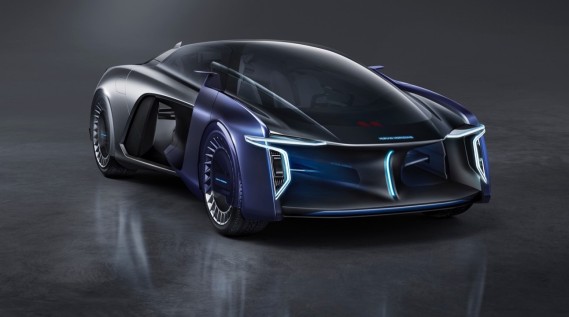
The Hypervelocity concept
With the H car, says Shyr, “we were exploring the boundary of how a human can move.” It is a vehicle for a person who would enjoy driving, he says. They designed a computer assisted model, and built a clay model, then decided they hadn’t pushed the boundaries enough, trashed that, and went back to the drawing board.
The current version has some cool features such as a sliding steering wheel – enabled by its steer-by-wire system, or to quote a press release: “The RE.C.E.S.S. or RE-configurable Cockpit Electric Steering System. It would enable anyone “to-be-or-not-to-be-the-captain “at any time, ……because we know that you want to have a choice to work or relax.” The H car also has flexible seating positions, which I guess also helps anyone to be or not to be the captain.
They had a lot of interior space to play with in the design process because the car is powered by in-wheel electric motors produced by Protean Electric! Yep, the Protean Electric led by KY Chan, that I blogged about in late October. Indeed, Shyr told me about the cooperation before Protean put out the official press release. I hadn’t gotten around to writing this up or I would have broken the news.
Human Horizons also has debuted a smaller electric vehicle concept, the A Agility. I can’t even describe it so will just past in the HH description: “The Concept A Active-agility presents a concept based upon a passenger capsule that can be connected to different sub-systems by the top or the bottom to provide different modes of transportation. Its POD (Personification-On-Demand system) provides an intelligent and efficient solution for people to move around and keep connected.”
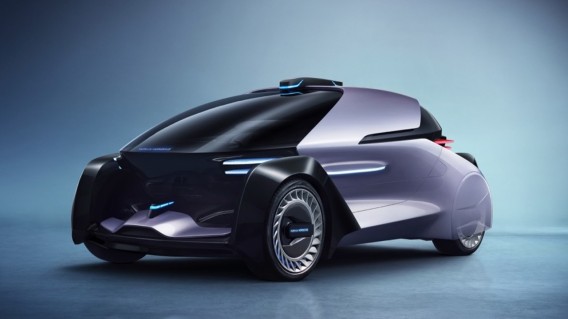
Active-agility concept
Human Horizons will launch its first product in 2021, says Shyr, and is forming a sales channel right now. The first vehicle to market won’t be one of the futuristic concept vehicles. No, it will be a mainstream electric vehicle offering a portfolio of electric powertrains including in-wheel motors, he says. They will create a vehicle brand name in mid-2019, says Shyr.
The vehicles will be produced at several plants that are “in the works,” says Shyr. It seems both are in Yancheng, a city in northeastern Jiangsu province. The plants are “80 percent greenfield,” he says.
Connections matter
Human Horizons will build more than just plants in Yancheng. The city will also be the testing ground for the smart car-smart road-smart city ecosystem Human Horizons is developing, says Shyr. The Yancheng government is an investor in Human Horizons, which should smooth the approval process quite a bit. “That is why we are so confident we are going forward,” says Shyr.
He figures a working model of the smart ecosystem concept will be in place “no later than 2025.” There isn’t anything revolutionary about the technology, says Shyr. What is revolutionary is the way Human Horizons will put it all together, he says. “A lot of new startups concentrate on the vehicle alone,” says Shyr. “Does this world need another car company? No.”
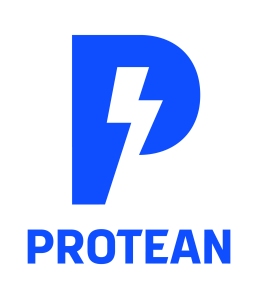
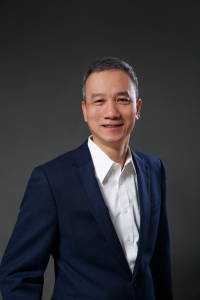
The proof is in the pudding, as the saying goes. I’m not exactly sure what that means, but I think it applies to Protean Electric’s current situation. I’ve been writing about Protean since 2012. The “start-up” is still chugging along, still working to get automakers to give its in-wheel electric motors a try. “We have found it is very difficult to convince OEMS to use our motor,” Protean CEO KY Chan told me recently. It needs some pudding to prove its product. That may finally be happening.
Electrification takes many forms. Protean Electric, based in the U.S., U.K., and China, makes in-wheel electric motors. To quote its web site: “Our aim has been to create an in-wheel motor with integrated power electronics and digital control that can be packaged with a brake as a single product.”
Though it is ten years old, Protean is still in start-up mode as it is still “burning shareholder capital,” says Chan. It landed $40 million Series E funding earlier this year in new equity and manufacturing licenses. The majority of that funding – some $30 million – came from Weifu High Technology Group Co. Ltd, which now owns 12.34 percent of Protean, according to an announcements by Weifu and Protean. The two companies will establish a joint venture in Wuxi, China to manufacture ProteanDrive Pd18 in-wheel motors, which are designed to fit an 18-inch wheel rim.
Protean has another site in China, in Tianjin. I wrote about that in March of 2016. It houses what Chan refers to as a “prototype line” where it can produce motors for customers that need small quantities – several dozen, say – to help those customers make up their minds about the product. That plant has also aided Protean in developing its supply chain in China. “When Weifu and U.S. licensees want to scale up, they can rely on our original suppliers,” says Chan.
The in-wheel motor maker has received small purchase orders from eleven OEMS in China to test the technology, he says. If they decide to scale up, they will buy the motors from the Weifu plant, says Chan.
Protean doesn’t plan to expand the Tianjin site into large scale manufacturing, he adds. “Our mission is in the next two years before our China licensees scale up, they can rely on Tianjin to build prototypes.”
As we all know, or anyone reading this is likely to know, China has an ambitious plan to grow its electric vehicle sector. It has mandated that automakers produce a certain volume of electrified vehicles or pay fines – a policy similar to California’s Zero Emission Vehicle (ZEV) policy, which indeed was a model for the China policy. Concurrently, Beijing is rolling out an updated Corporate Average Fuel Consumption (CAFC) policy. Automakers must meet that as well. So, OEMs in China are interested in Protean’s in-wheel motors, which can help meet both targets as they can also improve fuel efficiency.
The key, of course, is to get OEMs to try the motors. And while Protean has always believe its biggest opportunities would be in the passenger vehicle segment, says Chan, for the next several years, “our business will mainly come from the logistical vehicle manufacturers.” Indeed, in March of 2018 Protean signed an agreement with Consolidated Metco Inc. (ConMet) to develop in-wheel motors for the medium- and heavy-duty vehicle markets.
ConMet, based in Vancouver, WA, is a global supplier of components to the commercial vehicle markets. Protean and ConMet have already put a motor and battery system together and are promoting the system to customers such as Volvo Heavy Duty and Scania, says Chan.
It also just announced a deal with Linamar Corp. , a huge Canadian automotive parts manufacturer, under which Linamar will manufacture Protean’s in-wheel motors for both the commercial and passenger car segments.
Waste delivery vehicles is a promising area, says Chan. Garbage trucks, as such vehicles are commonly known, stop and start over and over again. “Using a Protean motor would save a lot of energy,” says Chan. Another promising segment – cold chain delivery trucks that deliver to supermarkets and the like. The container is a big refrigerator that traditionally uses a diesel engine as a compressor to keep the container cold.
“What ConMet and Protean would be providing is a way to use the action of the vehicle to generate energy through the Protean motor, that can be used for the refrigeration,” says Chan. The product they offer is a complete system including a battery, electric motor, and battery management system, says Chan. Competitors generally only offer the electric motor, says Chan.
Protean is also talking with another customer in the U.S. that he can’t reveal, says Chan. That customer, a major Tier One supplier in the Detroit area, has agreed to become a Protean licensee. The deal is quite important for Protean because it will give major OEMS more comfort in dealing with Protean, says Chan. Until now, they have hesitated because of his firm’s small size, he says. That pudding is beginning to gel.
Given its growing U.S. business, Chan has relocated from Asia to the San Francisco Bay Area. His kids all work in the Bay Area, so that was another factor, he says. It has a small presence, just Chan, a VP of U.S. sales, and a few others. “Hiring is very difficult” in the Bay Area, he sighs.
Back in China, Protean is eyeing another business opportunity as well – ride hailing. The central government in China has recognized that convincing Chinese consumers to buy electric vehicles may be even tougher when the current hefty incentives are phased out by 2021. So, Beijing is encouraging Didi Chuxing, the giant of the ride-hailing segment in China, to go all electric, he says.
Didi doesn’t want to produce its own EVs; it is encouraging Chinese automakers such as FAW and SAIC and BAIC to produce them and to lease the EVs to Didi drivers. “I would like Didi to mention to the OEMs that they should look at in-wheel motors,” says Chan.
GYON adds name to long list of Chinese EV startups
LOS ANGELES — Can you believe it? Another EV startup — that will produce “affordable luxury” electric vehicles — has popped up. It is called GYON — name is an acronym for “Grow Your Own Niche.” I attended an event here on August 8 to announce GYON’s partnership with the Gaffoglio Family Metalcrafters, a firm in Fountain Valley, CA.

GYON’s mission is to “create the next generation of electric, intelligent, connected, and socialized transportation products and services.” Sounds really familiar, I know. And yes, we are all rolling our eyes. I asked Joe Chao, the co-founder and president of GYON, what made his EV company special. “We are not just a car company,” he told me. “We are a system provider.”
Although details of the actual car, battery, and charger were scare, GYON showed a photo of a “Smart City Ecosystem” circle — car operation-AI Smart-Charging Network-Finance-Connectivity — which make up the system, I guess. Not exactly new but a hot topic in China. GYON is headquartered in the southwest China city of Chengdu, and has a lot of support from the local government, Joe told me.
It is true that the local governments in China all want their own EV champion. And Chengdu has a pretty solid automotive base — Volkswagen, Toyota, and Volvo have plants there. I guess the Chengdu government feels like it needs its own EV startup.
GYON aims to build two production plants in Chengdu with a total capacity of 480,000 units. The plan calls for one plant to be finished in 2021, the second in 2024. But, Chao admitted, that depends on negotiations with the Chengdu government going well. Control seems to be a sticking point — GYON wants full control to ensure quality, etc.
Most — actually all except for me — of the journalists there were Chinese, most flown over from China, it seems. The first press release was in Chinese. So the audience was clearly in China. Los Angeles was chosen as the location for the event because Gaffoglio Family Metalcrafters are based nearby in Orange County.
GFM will produce a prototype for GYON. No sketch was available — the whole thing is pretty nascent, was my feeling. But GFM does have a stellar list of clients and accomplishments so I expect the prototype — which may be rolled out at CES in 2020 — will look great.
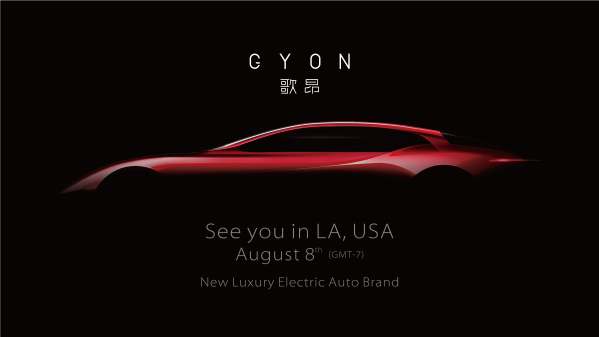
GYON is super ambitious — it says it will turn out nine vehicles in eight years. They will be in the sedan, MPV, SUV, and even station wagon segments. The first models look to be small EVs, however, A and B segment or sub-compact and compact. GYON says it will turn out “affordable luxury” cars and the price point for the first models — 100,000 to 200,000 RMB, or US $14,668 to $29,337 at current exchange rates — is pretty darned affordable. It will be interesting to see how much luxury GYON can pack into the vehicles at that price.
Joe pointed out that the quality of an EV maker’s team is very important in landing funding, and he has assembled a pretty stellar group. Joe Chao is, of course, the former head of DaimlerChrysler’s China operations. He oversaw the production of the Beijing-Benz plant whose opening I attended. He also was an SVP at Chrysler, worked at GM, and after leaving DaimlerChrysler worked for Fisker and Karma in China, among others. He’s been around.
Also at the event were Jacky Xian, a GYON investor and CEO of Sitech; Sunho Park, head of GYON quality center and also quality manager at Sitech; Sebastien Yang, manager of GYON marketing and product planning; and Thomas Zhang, chief engineer. All have impressive automotive CVs.
Another common trait is that many have connections to Sitech, another EV maker, which is backed by FAW. Sitech launched it own little EV, the Dev1, earlier this year. Joe says GYON and the Dev1 won’t share technology. Sitech is an investor in GYON, however, which means FAW is an investor, in a way. As with so many companies in China, the ownership structure of GYON is a tangled web.
Joe said that GYON might use FAW’s manufacturing capacity if GYON had a production-ready vehicle and its plants weren’t ready. Loose FAW ties aside, GYON doesn’t have a close relationship with an established automaker. Its execs, who do have a lot of automotive experience among them, touted this as a risk and an advantage (they would, of course…).
“We don’t have a big uncle behind us,” said Chao. “It is up to us. This is about risk..” But, he said, they were not going to use that as an excuse not to found GYON.
Jackie Xian added: “In China, people have an open mind to welcome a new brand.”
Not sure how true that is.
Magna aims to sell EVs in China through JV with BAIC
Magna International is jumping on the China EV band wagon. Well, that’s not entirely correct. It was already a major player in the EV component space. Now, Magna will form two joint ventures with Beijing Automotive Industry Holding Corp aka BAIC. One joint venture will focus on engineering, the other will manufacture pure electric vehicles.
The announcement Magna and BAIC would work together first came out in April of this year. That announcement proclaimed the agreement was between BAIC and Magna Steyr, the Austria-based contract vehicle manufacturer that is part of Magna International.

The actual JV was announced in mid-June, but the parties were Magna (no Steyr) and BAIC. That is because Magna has decided to refer to all its subsidiaries as simply Magna, Klaus Drobnak, vice president fuel systems for Magna Steyr, oops, I mean Magna, told me. Drobnak heads up Magna Steyr’s Asia business. Magna Steyr is known for engineering and manufacturing vehicles for other companies.
Magna International’s supplier business has long had a thriving presence in China. Its components are in pretty much every foreign brand car in China and many domestically-badged vehicles as well. Why jump into vehicle manufacturing in ‘China now, I asked? China “is a large market, BAIC is a strong partner. We see is as a good opportunity for us,” says Drobnak.

I saw that coming. The large market, that is. In 2017, China was the world’s largest market for electric vehicles, including battery electric and plug-in hybrid electric vehicles. Some 700,000 BEVs and PHEVs, plus a few hydrogen fuel cell vehicles, were sold in the Middle Kingdom in 2017. BAIC’s EC series of electric vehicles was far and away the top seller.
By 2025, “the forecast for (sales of) all electric vehicles in China is 5 million,” says Drobnak. That is the government’s target, I remind him. But given that this is China, that target will likely be met. Government regulations are another compelling reason to start producing EVs in China now. Automakers must produce a certain number of electrified vehicles each year because of several government policies, which I wrote about for Wards Auto and you can read about here.
“We think (electric vehicles) is going to be a strongly growing segment,” says Drobnak. A good bet.
Of course, the main customers for electric vehicles in China thus far have been government fleets. That doesn’t worry Drobnak. “The first (markets for EVs) are always fleets,” he says. Drobnak figures Chinese consumers concerned about pollution will warm to electric vehicles. He also thinks that the daily driving behavior of China’s city-dwellers fits well with the range of electric vehicles.
One market driver Drobnak isn’t counting on are vehicle registration policies making EVs license plates easier or cheaper to obtain. Though they are major reason behind consumer EV sales in many large cities now, Drobnak figures those incentives will vanish as the volume of EVs on the road rises.
China’s healthy purchase subsidies are also scheduled to be phased out in a few years. Drobnak didn’t sound too worried about that. The price of EVs is “definitely coming down” as volumes increase, he says. As for batteries, which account for the bulk of an EVs cost, their price is also coming down as volumes increase and cell manufacturers become more capable, says Drobnak. “I am positive the sale price (for electric vehicles) will go in the right direction,” he says.
Two JVs
Magna will be the majority owner of the engineering joint venture with BAIC; the Chinese company will be the majority owner of the electric vehicle JV. The partnership hasn’t been approved by the central government yet, but BAIC is owned by the Beijing municipal government. “Our expectation is (the two JVs) will be approved,” says Drobnak.
BAIC, through its Beijing Electric Vehicle subsidiary, already produces the EC series, which with sales of 13,169 units in 2017. But those are small, inexpensive EVs. With the JV, BAIC will move into higher-priced segments.
The engineering JV will develop a smart EV platform suitable for a medium or premium segment model. Drobnak declined to say what style of vehicle the JV would make, but there are plenty of clues.
Magna contracts to produce one other all-electric vehicle, the just-launched Jaguar I-PACE SUV.

Magna Steyr produces the Jaguar I-Pace EV.
The SUV/CUV segment in China is the fastest growing. You be the judge of what style vehicle the Magna BAIC JV is likely to produce.
Production will be at a brownfield plant –meaning an existing plant BAIC owns — in Zhenjiang, in east China’s Jiangsu province. That plant has an annual production capacity of 180,000 units. Start of production is set for mid-2020, says Drobnak.
Zhenjiang is on the banks of the Yangtze River between Suzhou and Nanjing. That puts it smack in the middle of a technology and manufacturing hotbed in China, as well as near automakers SAIC – GM, and SAIC VW. There should be a good supplier base there, but a lot of competition for staff.
Magna has 51 manufacturing plants in China producing components ranging from electrical systems to structural and powertrain components to transmissions. It has more than 22,600 employees in China. The new JVs will boost that by more than 3,500.
Why did you decide to form a joint venture with BAIC rather than another automaker, I asked? “BAIC group has been a customer to our engineering and components for quite a while. This came out of our regular business discussion,” says Drobnak.
Beijing just said it will allow foreign automakers to own 100 percent of an electric vehicle manufacturing company. Why not go it alone, I asked Drobnak?
Most automakers are sticking with a Chinese partner, he points out. Magna is no different. Also, BAIC is will be the new entities’ first and primary customer, he adds.
.

